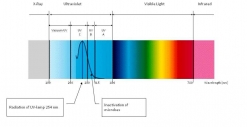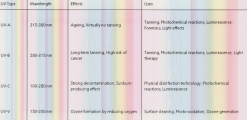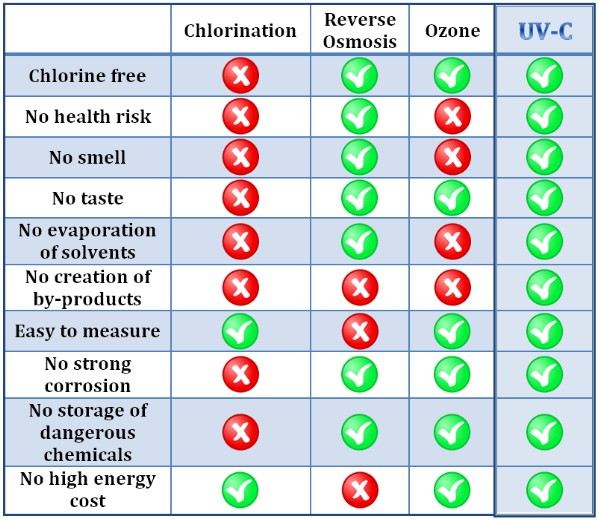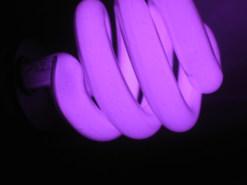Ultraviolet irradiation

The UV spectrum itself is further divided into four components according to wavelength: UV-A, UV-B, UV-C, and Vacuum UV (the shorter the wavelength the greater the energy irradiated). These groups of UV light have varying biological and physical effects and are thus put to different uses.
Principle of UV-C disinfection
 The
genetic material of all living organisms is deoxyribonucleic acid
(DNA), which is composed of the four bases (adenine, guanine, thymine,
and cytosine, sugar, and phosphates in a double-helix structure.
Ultraviolet (UV) disinfection involves the use of radiation contained in
the UV-C segment of the UV spectrum, between the wavelengths of 250 and
270 nm, to deactivate the nuclear and cellular structure of
micro-organisms.
The
genetic material of all living organisms is deoxyribonucleic acid
(DNA), which is composed of the four bases (adenine, guanine, thymine,
and cytosine, sugar, and phosphates in a double-helix structure.
Ultraviolet (UV) disinfection involves the use of radiation contained in
the UV-C segment of the UV spectrum, between the wavelengths of 250 and
270 nm, to deactivate the nuclear and cellular structure of
micro-organisms.
UV-C irradiation disrupts the double helix structure by causing the formation of base dimmers (paired bases as opposed to the A-T, G-C combinations. The formation of dimmers (AA, TT, GG, CC) destroys the cell physically and inhibits reproduction.
Vacuum UV odour removal
Vacuum UV (V-UV) is generated between 100 and 200 nm and propagates only through a vacuum since it is otherwise readily absorbed by the air. Ozone readily combines with other molecules and is thus used to oxidise molecules and remove odours.
Applications of UV-C disinfection and V-UV odour removal
Air disinfection and odour removal
UV-C radiation units installed in ventilation and air purification plants deactivate bacteria, mould fungus, yeasts and viruses which enter the ventilation or air-conditioning system from the exterior. Up to 99.99% effective, these systems may be used in almost any area of application in ventilation and air-conditioning system.
When combined with oxygen molecules ultraviolet radiation at 185 nm produces ozone (O3). Being highly reactive ozone exhibits strong oxidising properties and breaks down or reduces the offending compounds and odorants in the air. UV-lasers with a quartz glass quality that can produce ozone simultaneously emit radiation with a wavelength of 254 nm. They remove odour and sterilise the air at the same time. Ultraviolet radiation can also be used to break down ozone.
Air purification and odour removal systems may find uses in hospitals, medical practices, clean air rooms, exhaust air systems, offices, storage rooms, public rooms and rest-rooms, animal shelters and stables.
Water disinfection
There exist several methods to purify water for potable use, swimming pools, commercial enterprises, industrial processes, and irrigation, amongst other purposes. In all cases, UV-C disinfection neutralises all organic and some inorganic impurities. Depending upon the circumstances UV-C disinfection in combination with complementary methods significantly increases the effectiveness and efficiency of the treatment process.
The eco-friendliness and lack of harmful products makes UV-C radiation a popular choice for water purification. UV-C purification systems can be installed in households, residential communities, mobile stations (kiosks, camp-sites, outdoor stations), swimming pools, ponds, and aquariums, ultra-pure water systems, food processing, and water recycling and sewage treatment systems.
Surface disinfection
UV-C can be to safely and reliably sterilise surface areas. This method of cleaning is used in many applications as an alternative to thermal or chemical disinfection. UV-C disinfection works instantly and continuously, without the surface area being subjected to high temperatures or the use of chemicals. Investment, servicing and running costs are minimal, installation and handling is easy.
UV-C disinfection systems may be used in hospitals, medical practices, food and pharmaceutical and packaging industries.
UV-C radiation can also be used to delete the bit-pattern on microelectronics: the semi-conductor material of erasable programmable read-only memory (EPROM) devices is ionised by UV-C radiation, thus returning the EPROM to its original state.
Characteristics of UV-C disinfection and odour removal
UV-C
disinfection and V-UV  odour removal offers numerous significant
advantages in comparison to other methods such as chlorination,
filtration and oxidisation.
odour removal offers numerous significant
advantages in comparison to other methods such as chlorination,
filtration and oxidisation.
In particular there are no harmful by-products, toxic or non-toxic waste produced by the disinfection process, harmful side effects, negative environmental effects, or changes to the water chemistry.
As it is a physical method of disinfection, there is no danger of overdosing or over-exposure of the water, air or surface to UV irradiation. Most importantly, no organism is immune to UV-C irradiation and thus cannot acquire any resistance.
Furthermore, the process requires very little contact time for disinfection in comparison to other processes, does not affect the smell or taste of the treated water, and can be simultaneously combined with a variety of other disinfection and treatment processes.
In addition to its negligible impact on the environment, UV-C disinfection reduces the dependence on other costlier and environmentally-harmful methods of disinfection, increases economy due to low investments and maintenance costs, and guarantees reliability and safety due to sophisticated sensors.
However, UV-C disinfection is undermined by contaminated pipe networks and without regular sanitation and cleaning of the pipe network the lasting protective effect is mitigated; nonetheless such obstacles are easily overcome by combining UV-C disinfection with complementary methods.
At AquaNetto we develop the appropriate solution for your specific needs. As per the quality of the water or air to be treated we engineer environmentally-friendly and easy to operate solutions that combine various treatment methods to effectively and efficiently purify water and air.
Techno-pole 4
CH-3960 Sierre
Switzerland










